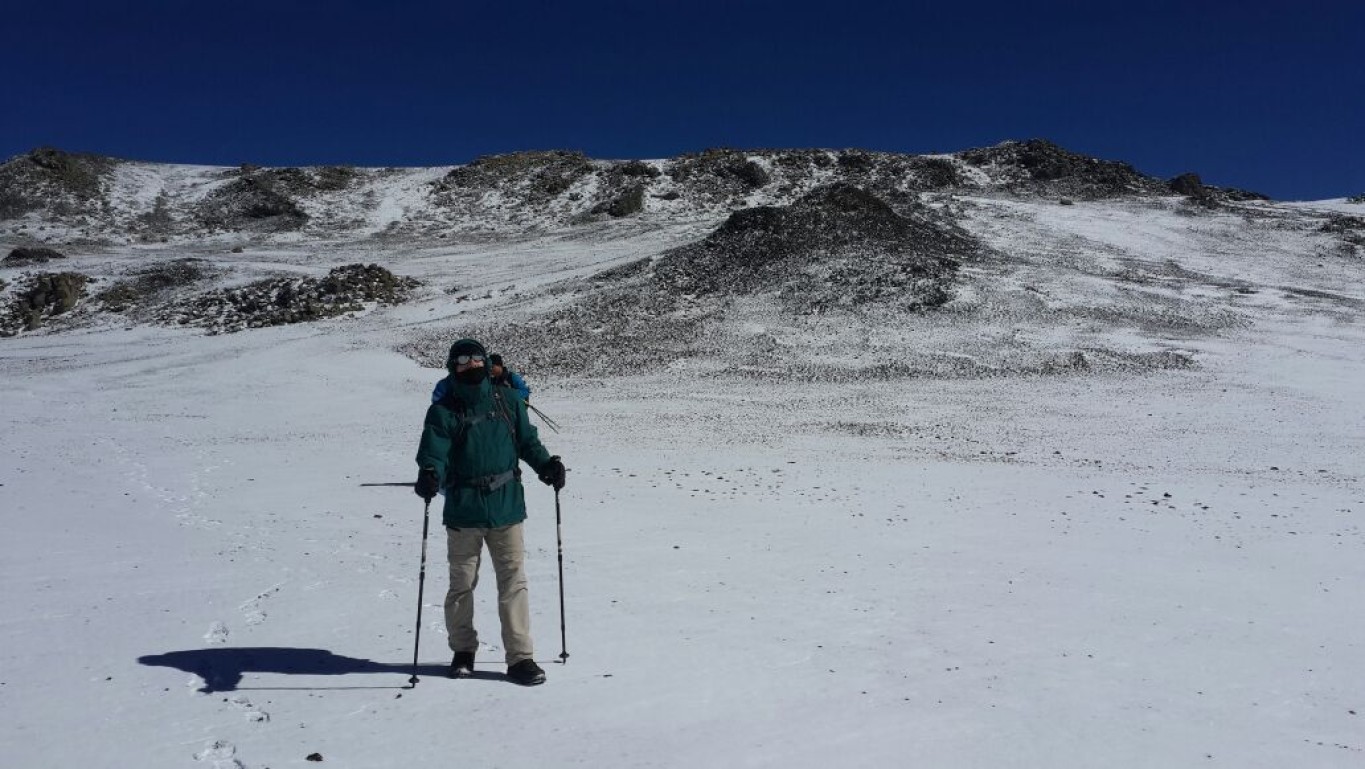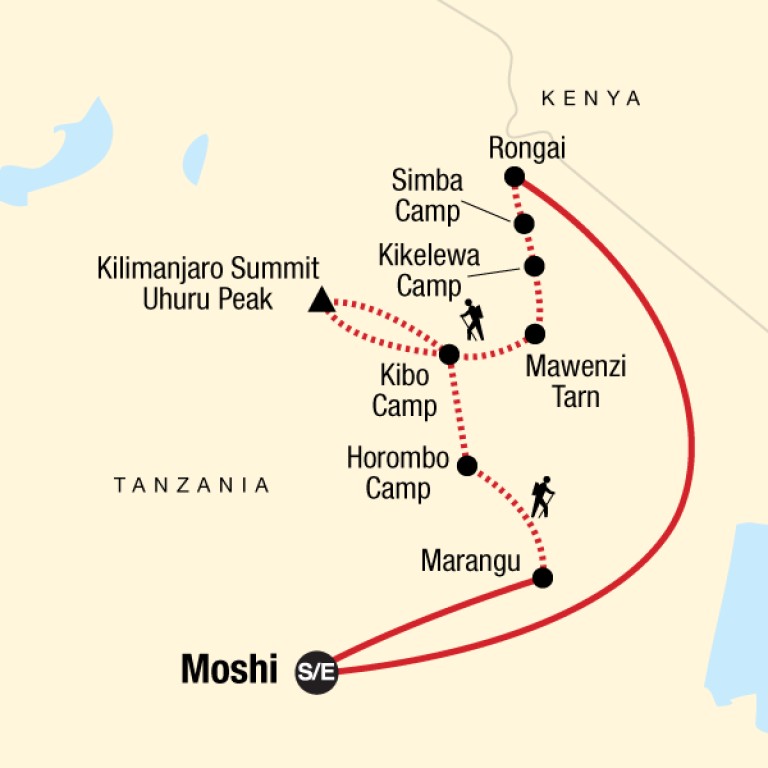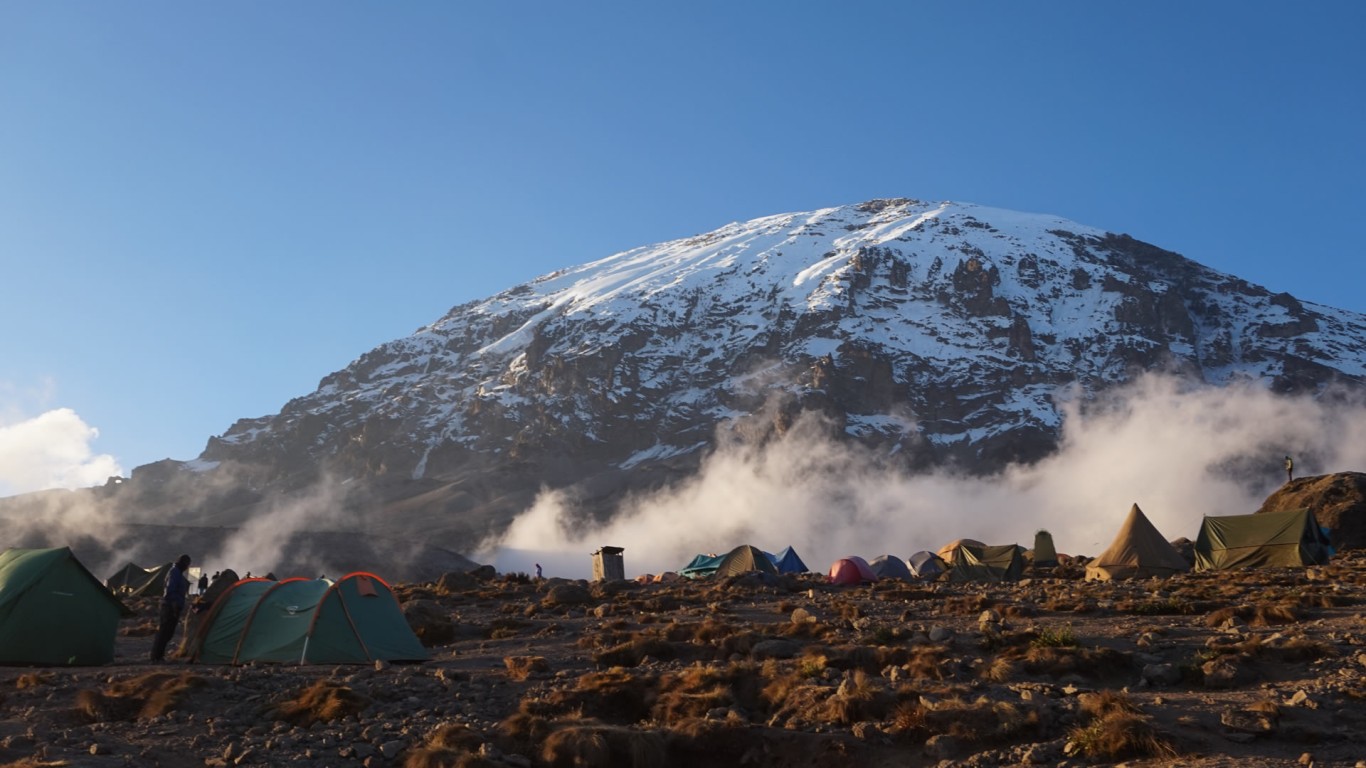From $2,400
Climb Mt. Kilimanjaro Via Lemosho Route 7 Days + 2 Nights Hotel in Moshi
- No Booking Charge
- Best Rate Gurantee

The Rongai route is the only route that approaches Kilimanjaro from the north, close to the Kenyan border. Though gaining popularity amongst climbers, Rongai has low traffic. It is the preferred route for those looking for an alternative to the crowded Marangu route, for those who would like a more remote hike, and for those who are climbing during the rainy season (the north side receives less precipitation).
The minimum number of days required for this route is six days, and seven days are recommended.
Although the scenery is not as varied as the western routes, Rongai makes up for this by passing through true wilderness areas for days before joining the Marangu route at Kibo camp. This route descends down the Marangu route. Rongai is a moderately difficult route, and is highly recommended, especially for those with less backpacking experience.
The itinerary below is for a six day Rongai Route trek. Seven and eight day trekkers usually spend an additional day at Mawenzi Tarn (4,300 meters) to acclimatise. Eight day trekkers also stop on day two at Rongai Second Cave (3,450 meters) before proceeding to Kikelewa Camp (3,600 meters).

Day 1 – Rongai Start Point (1,950 meters) to Rongai First Cave (2,620 meters)
Distance: ~6.5km / 3.5 miles
Trekking time: 3-4 hours
Zone: Rainforest
On day one Rongai Route trekkers are driven from either Moshi or Arusha to Marangu Gate for registration before being shuttled a further 70 kilometres on poor roads to the Rongai Start Point at 1,950 meters. The trek begins from Nale Moru village and follows a gradual and winding trail that first crosses maize fields before entering the rainforest. The first day’s hiking is easy going and you will arrive at Rongai First Cave (2,620 meters) around mid-afternoon, where you can freshen up and have dinner.
Day 2 – Rongai Cave (2,620 meters) to Kikelewa Camp (3,600 meters)
Distance: ~12km / 6.5 miles
Trekking time: 6-8 hours
Zone: Rainforest / Low Alpine Zone
On day two the hike continues from Rongai First Cave through the rainforest before transitioning into the low alpine moorland zone where you will notice the vegetation change to shrubs and grasses. You will stop for lunch at Rongai Second Cave (3,450 meters), 6km from the First Cave Camp, before turning east to Kikelewa Camp (3,600 meters) for your overnight stay. Depending on your tour operator, eight day trekkers might stop at Rongai Second Caves for the night before proceeding to Kikelewa Camp.
Day 3 – Kikelewa Camp (3,600 meters) to Mawenzi Tarn (4,300 meters)
Distance: ~4km / 2.5 miles
Trekking time: 3-4 hours
Zone: Low alpine zone / High alpine zone
Day three on the Rongai Route is a short, but steep climb from Kikelewa Camp to Mawenzi Tarn (4,300 meters) which sits in the shadow of the magnificent Mawenzi Peak. You will arrive at Mawenzi Tarn in time for lunch and then have the whole afternoon to explore the surrounding area and acclimatise.
Day 4 – Mawenzi Tarn (4,300 meters) to Kibo Hut (4,700 meters)
Distance: ~9km / 5.5 miles
Trekking time: 8-10 hours
Zone: High alpine zone
Day four is a long but gradual hike from Mawenzi Tarn heading west through the Saddle which is formed between the peaks of Kibo and Mawenzi, and up to Kibo Hut (4,700 meters). The route is dry, barren and rather inhospitable, but provides spectacular views of Kibo. At Kibo Hut you will get served dinner and will go to bed early as you will be awoken around 23:30 to begin your summit attempt. Trekkers should remember to prepare their gear, including headlamp, camera, insulated water and warm weather clothes before they go to sleep.
Note: Seven and Eight day trekkers typically hike from Mawenzi Tarn to Kibo Hut and back on day four. They then trek to Kibo Hut again on day five before continuing to Uhuru peak on day six / seven.
Day 5 – Kibo Hut (4,700 meters) to Uhuru Peak (5,895 meters) and then Horombo Hut (3,720 meters)
Distance: ~5.5km / 3 miles ascent and then 15km / 8 mile descent
Trekking time: 6-8 hours to the summit and then 5-8 hours to Horombo Hut
Zone: Glacial zone, high alpine zone and low alpine zone
Day five begins at midnight, after being awoken with tea and biscuits you will begin your ascent in the dark across a rocky path to the first check point, Hans Meyer Cave at 5,150 meters. You should have a break here and refuel on an energy bar. The path then zigzags and increases in steepness as you approach Gilman’s Point 2-3 hours later at 5,681 meters. You are now on Kibo’s crater rim, a huge achievement! But you still have a 200 meter ascent to trek to the summit, Uhuru Peak (5,895 meters). Dig deep to find the reserves and mental stamina to push yourself up the final slopes. At Uhuru Peak you will be able to stay briefly before descending back to Kibo Hut and on to Horombo Hut. In total you will be trekking upwards of 12-16 hours. It will be one of the longest days of your life but well worth it! Here’s the good news, beers can be bought at Horombo Hut!
Day 6 – Horombo Hut (3,720 meters) to Marangu Gate (1,870 meters)
Distance: ~20km / 13 miles
Trekking time: 6-8 hours
Zone: Low alpine zone and rainforest
The final day from Horombo Hut to Marangu Gate (1,870 meters) is a long one, nearly 20km! Your knees will be sore from the previous days hike so go slowly and make sure of your footing as you descend, using your trekking poles to limit the impact on your joints. At Marangu Gate, the place where you signed in 6 days ago, you will now sign-out. Those who got as far as Gilman’s Point but no further will be presented with a green certificate. Trekkers who made it all the way to Uhuru Peak will receive a gold certificate.
no
Arrange your trip in advance - book this tour now!

From $2,400

From $2,705

From $1,720